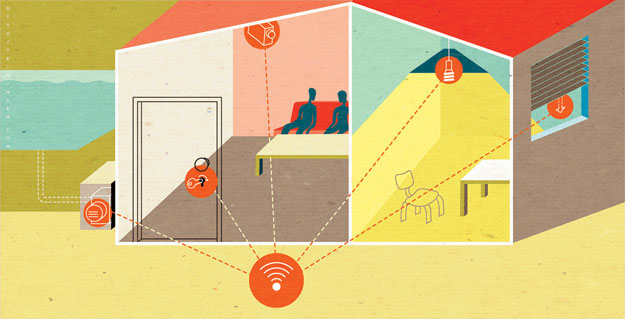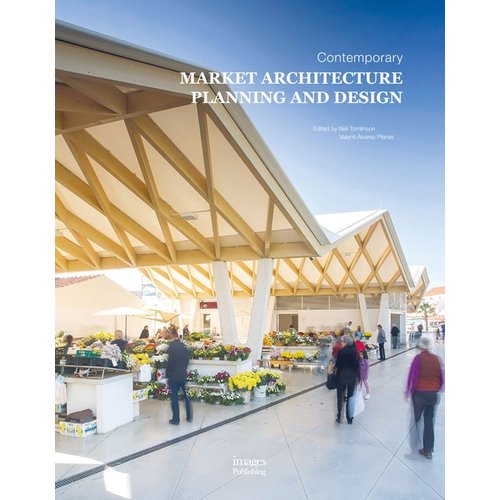Converging Networks
As building-control apps go mainstream, home-automation providers explore wireless options.

Illustration: © Otto Steininger
As building-control apps go mainstream, home-automation providers explore wireless options.
 |
| Illustration: © Otto Steininger |
The Apple Store isn't a place you would typically look for residential building components. But you can find a new Wi-Fi-enabled lighting system from Philips called HUE there. This screw-in LED replacement for traditional bulbs can be easily controlled for color, color temperature, and intensity from a computer or smartphone. Google's recent $3.2 billion purchase of the Palo Alto, California–based Nest Labs and its web-accessible programmable thermostats, smoke detectors, and carbon monoxide detectors is yet another development turning the notion of home automation—often a complex configuration of wires and cables linked to devices with rigid protocols—into a viable option for new construction and also renovation projects.
“This is the advent of the 'Internet of Things'; everything is going to be controlled through Wi-Fi,” says lighting designer Christopher Thompson, who runs the Seattle design firm Studio Lux. As a result, says Thompson, “Home automation is undergoing a huge shift.”
Improved wireless networks are enabling providers of whole-home systems to remotely control a wider array of devices and functions. Suppliers are also striving to simplify the operation of their systems to meet homeowner requests to control everything via smartphone and tablet—the new universal remotes.
Lutron was among the first to connect the whole house without wires in the mid-1990s, when it launched a radio-frequency (RF) system called RadioRA that relied on a rack-mounted central hub to relay messages between the wireless control units and light switches. At the time, it was developed to be a second-tier solution for retrofit jobs where running wires would be too costly.
Many home-control providers are moving beyond the fixed hub-and-spoke network model to manage more than lighting and shades, adding climate control, security, home entertainment, appliances, even locks to their offerings. According to Tom Barnett, the residential marketing director at building-controls solutions manufacturer Crestron, interference from neighboring wireless devices makes it difficult for hub-and-spoke configurations to deliver the uninterrupted bandwidth required to control a diverse array of devices. Barnett notes that the Wi-Fi networks used for home Internet connectivity, for example, offer great bandwidth but notoriously poor reliability.
As a solution, the Crestron InfiNET EX wireless system relies on a mesh network, which turns every automated component into a miniature hub. This is said to assure that the message will get through when the user presses a button on the remote control, explains Barnett, even if its signal can't reach the base station directly. For instance, a signal will be picked up and passed along by the controller on bedroom shades to whatever components the shade controller can reach, and the message will bounce to the base, kicking off a programmed set of actions. (Barnett claims that pressing a particular button even sends his dog upstairs because, when the lights and TV go off downstairs, it knows it's time for bed.)
Meanwhile, Lutron has developed a fifth-generation RF system, upgrading its fixed-hub network with what the company claims is an extremely stable and interference-resistant band frequency. According to engineering manager Matt Swatsky, the new technology, dubbed Clear Connect, can encompass more than 10,000 square feet as reliably as a wired system.
In a recent vote of confidence for remote accessibility, luxury homebuilder Toll Brothers announced it is offering the Control4 system—controllable from a variety of devices—as a buyer option.
Still, there are circumstances where some clients remain unwilling to cut the cord. When Portland, Oregon–based architects Allied Works designed a home (see RECORD Houses, page 74) in a rural New York State location for a couple with a substantial art collection, the design team decided to go with a wired system. The country home's sophisticated system operates, among other things, museum-grade climate controls that protect the art from temperature and humidity swings. Allied Works principal Kyle Lommen says they went with a wired system because technical support would be slow in coming if a wireless system went down.
Wired systems are already giving way to hybrid configurations, and Lommen predicts that, in the future, those will ultimately give way to completely wireless and Internet-based solutions. The firm is already considering a wire-free whole-building system for the 160,000-square-foot National Music Centre in Calgary, Alberta. The direction, says Lommen, is clear.



